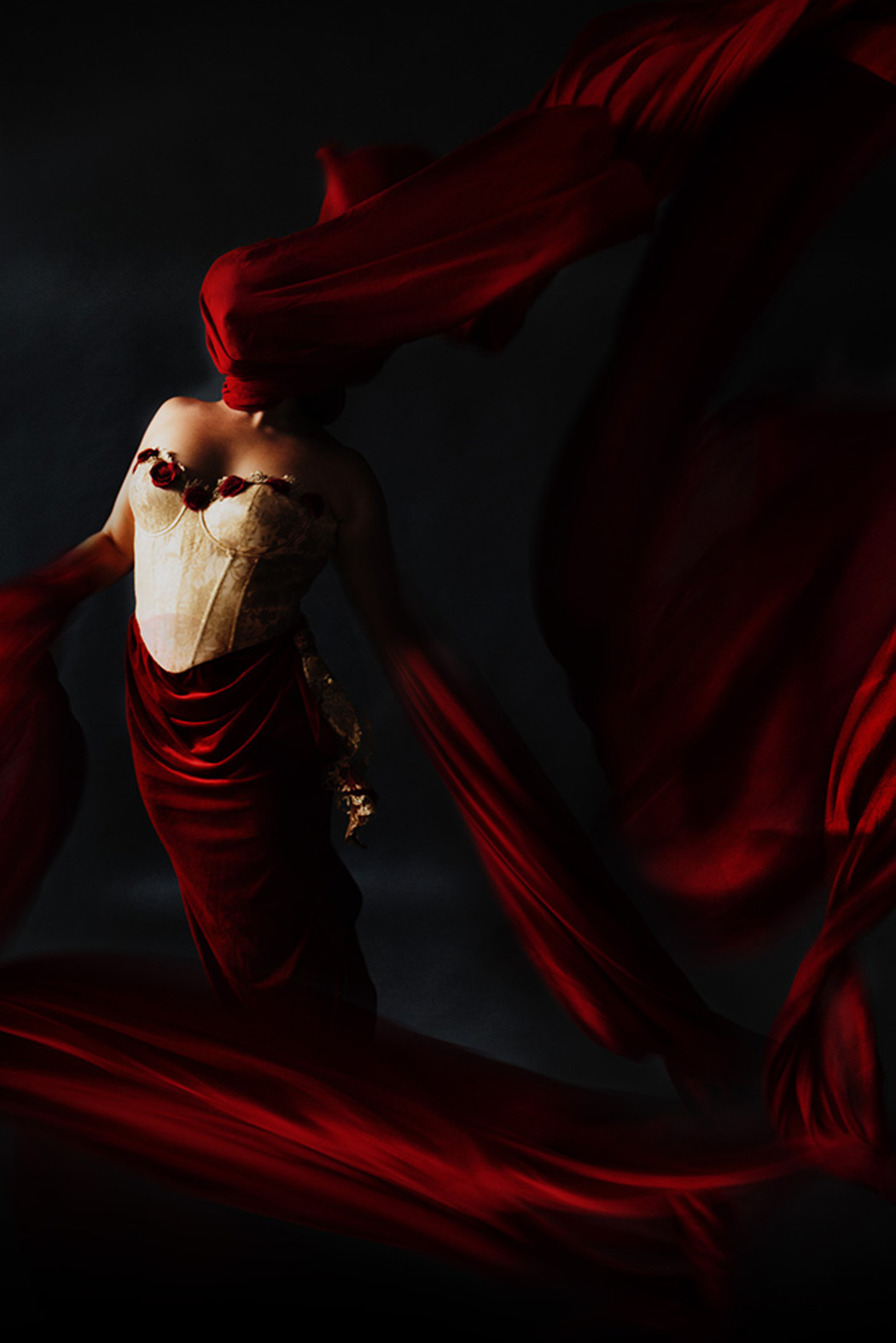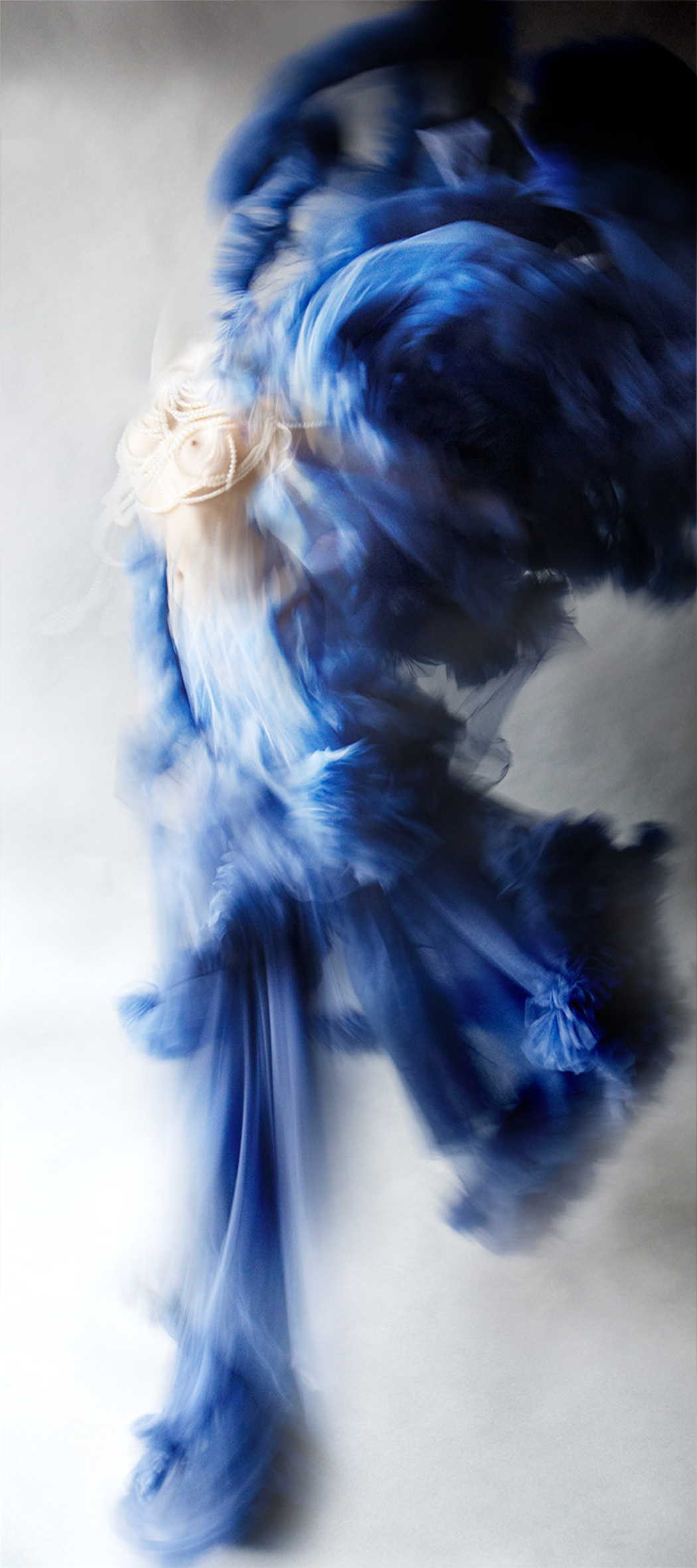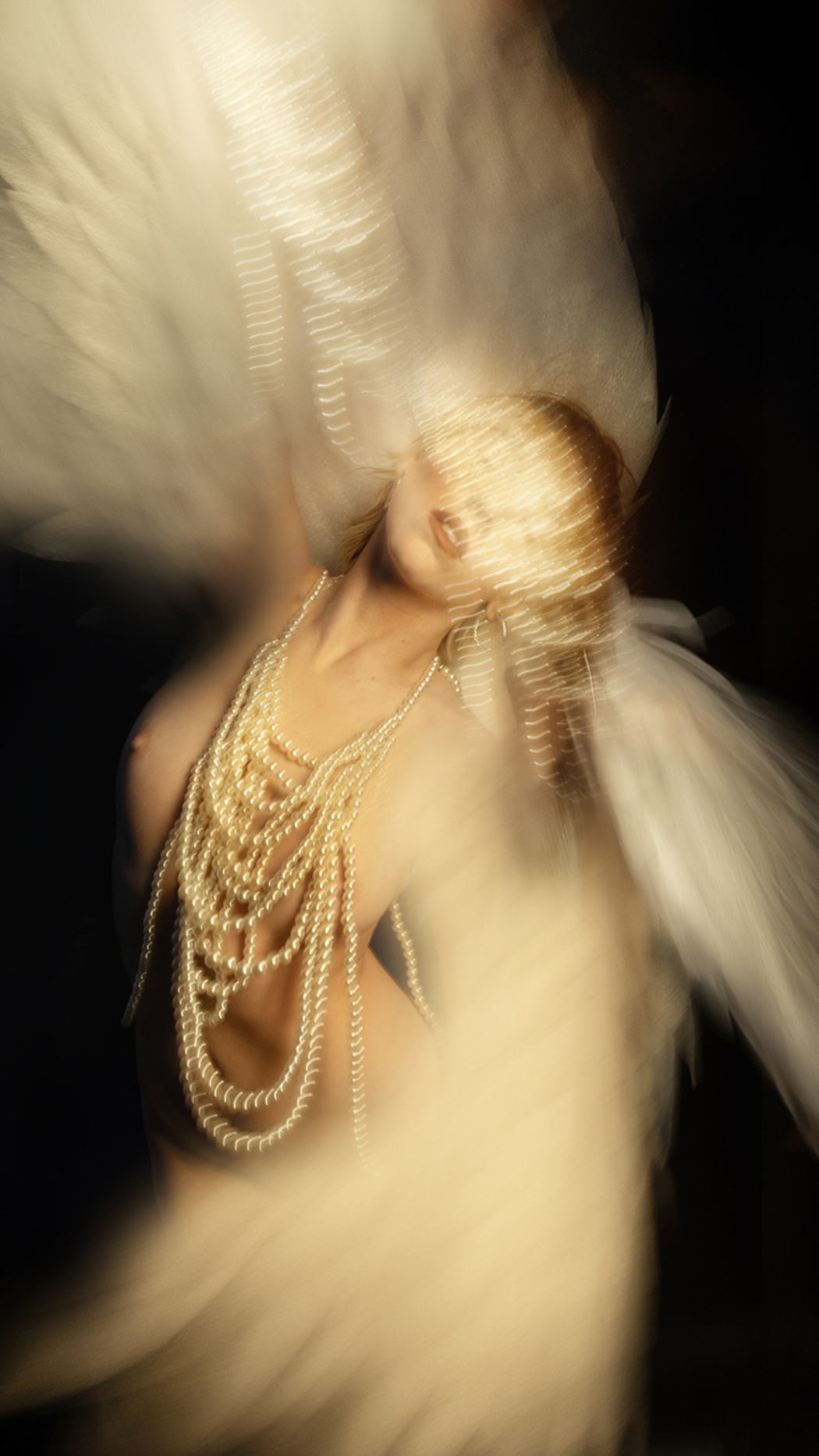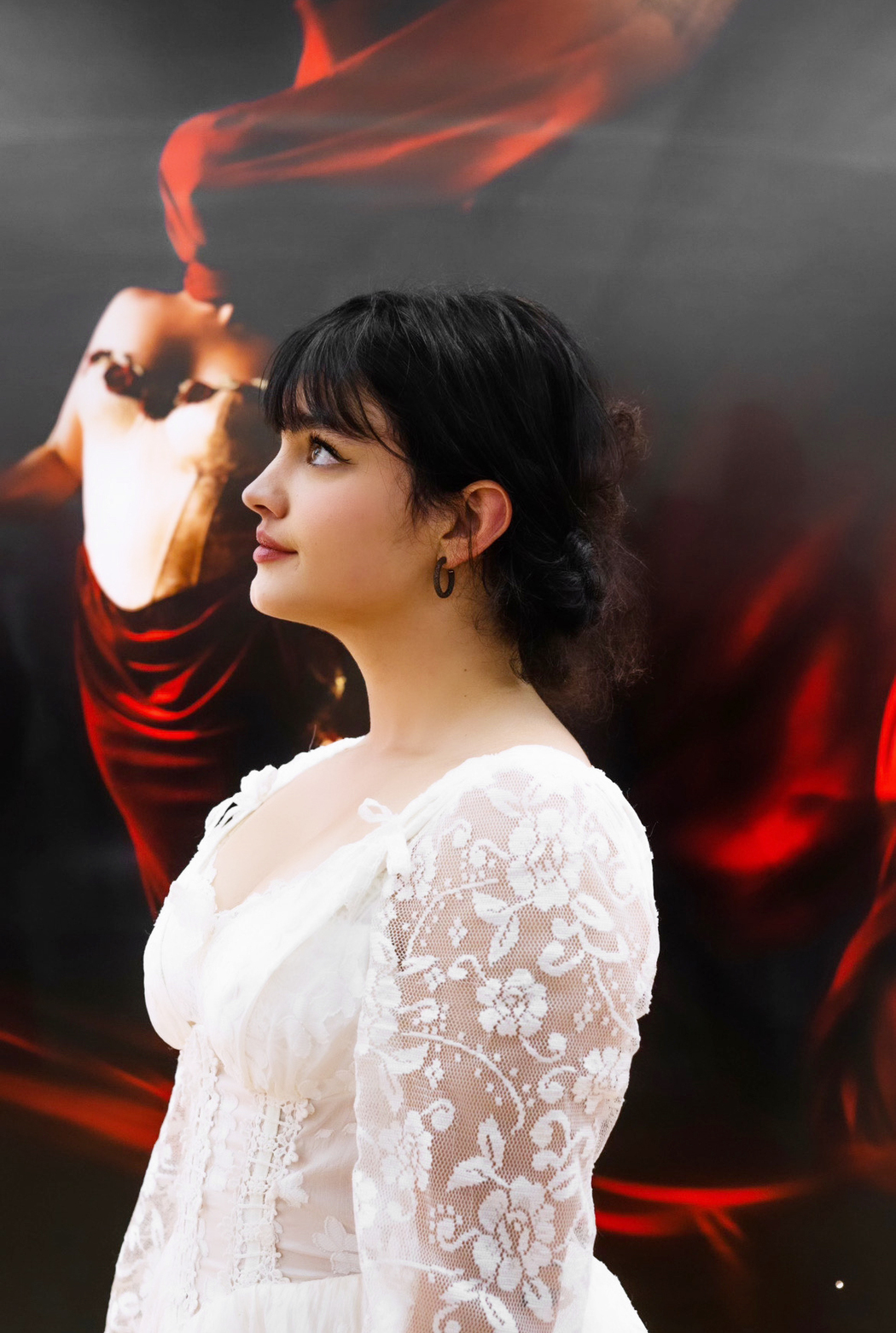Rizlane
Your photographs possess a painterly and almost otherworldly quality. Can you walk us through your creative process—how does a piece begin and evolve?
The most essential element of my artistic process is energy—particularly the embodiment of movement and presence. My work begins with a vision or an inner impulse, often rooted in a poetic or symbolic intention. In the studio, I revisit this vision through breath, gestures, and spoken word, allowing it to guide the body and atmosphere of the session.
Movement plays a central role in my compositions. I often work with long exposures—ranging from 0.4 to 2 seconds—so that the camera captures the ephemeral, the in-between, a kind of consciousness within randomness. This technique allows me to dissolve the mechanical nature of photography and evoke a sensation that feels closer to a brushstroke or a surreal flow of energy.
After each session, I am left with a multitude of images. I carefully select and blend between 15 to 20 photographs, keeping only the fragments that carry emotional resonance or visual transformation. Through layering and compositing, I sculpt a final image by both subtracting and adding—until what remains speaks with a universal language, something beyond the visible. The final piece is an alchemical process of transmutation—where photography becomes painting, and the human form becomes a vessel for the unseen.
You describe each session as a ritual. What role does spirituality play in the conception and execution of your work?
It begins for me with the idea of the blank page—an infinite space where creation is unstoppable. Spirituality becomes a vortex, a place where everything must be rediscovered, reconstructed, and reinterpreted. In my photographic practice, it is the primordial light entering the lens—an invisible force that mirrors the very nature of how an image is formed, through fragments of light. In that sense, spirituality is both the source and the substance of the image: a sacred breath that animates the unseen and transforms it into form.
In my artistic universe, spirituality is deeply intertwined with consciousness, meditation, and the embrace of the present moment. It allows both myself and my muses to ground ourselves, to become fully present, and to embody a deeper awareness. I see creation as a direct connection to our inner source—our personal power—and in that space, spirituality becomes both an ally and a guide. It feels like a presence beyond the visible, like a sacred friend who whispers the rhythm of the process.
Spirituality invites me to surrender, to trust the unknown, and to listen. It reconnects me to what has been forgotten—our inner fire, the myths and ancestral knowledge where humans were once considered as sacred as the gods. It reminds me of humility and awakens curiosity. I believe we’ve forgotten that we’ve forgotten, and through art and spirituality, we begin to remember…
This curiosity leads us back to ancient ways of living and believing. It opens a space where the sacred feminine and masculine can be explored and reclaimed. Spirituality encourages us to question, to ascend, to seek. It offers a form of freedom.
Thus, spirituality forms the very foundation of my creation and of my photographic-paintings. It is the invisible thread that runs through everything—present even before the image is captured, guiding the intention and energy behind each gesture.
Art, then, becomes the ultimate act of reconnection—with mystery, with memory, with the sacred. It’s a portal where the human and the magical converge, where we can rediscover our real reality—the one we carry within.
 Rizlane | La Tisseuse de Bonnes Augures
Rizlane | La Tisseuse de Bonnes Augures
The use of pearls, flowing fabric, and motion in your images evokes a strong sense of feminine power and vulnerability. How do you choose the symbols that appear in your work?
There are two simultaneous forces at play when I choose the symbols that inhabit my images—one intuitive and abstract, the other more tangible and grounded.
As a photographer, I work with what I call “material pigments.” Unlike painters who use oil or natural pigment on canvas, I work with textures, objects, and matter itself: fabrics, jewelry, precious stones, costumes, natural elements. These become my palette. Each item I select—whether a pearl necklace, a piece of silk, or a stone—is not simply a prop, but a pigment of meaning, charged with intention. Their presence arises from an inner call, a desire to explore, to heal, to ascend, to understand, or simply to feel.
These objects become symbols—vital keys to our incarnation as human beings. They carry energy, memory, and archetypal resonance. For me, the use of matter is not about consumption or aesthetic decoration, but about embodiment. It’s about returning to the essential role of matter as a vessel for spirit, for transformation. I see these objects not just as adornment, but as sacred tools—humbly grounding the body in something real, while also pointing to something ancestral and invisible.
There is also a personal evolution at play. The symbols I use—pearls, serpents, veils, stones—often arrive unannounced, like echoes from within. I do not choose them so much as they choose me. Over time, I begin to understand their deeper meanings. A strand of pearls, for example, is not merely an aesthetic element. It becomes a pigment of femininity, fluidity, memory—perhaps a prayer. Where a painter might use blue acrylic to suggest the ocean and evoke birth, Venus, or abundance—I choose a pearl necklace. It carries the same symbolic weight, but embodied in form, light, and presence.
Ultimately, each symbol is a living metaphor—an offering to the viewer, a mirror of our collective mythology, and a thread connecting the physical and the spiritual realms.
What does it mean for you to sign each artwork with a diamond? How does this act elevate photography into the realm of precious, sacred art?
The idea of the diamond came to me instinctively. It felt like a quiet revolution, a symbolic gesture rooted in reverence. Today, the diamond is central to my artistic practice. It evokes time, secrecy, rarity, divinity, and most importantly—light itself. And light is the very essence of photography.
To sign each artwork with a diamond is to return to something alchemical, to honor the image as a living relic. In a world where photography can be infinitely reproduced, this gesture asserts uniqueness. The physicality of fine art photography is essential to me—its weight, its texture, its presence. It’s only when a piece is printed, framed, and held in space that it reaches its full potential. At that moment, it becomes a jewel. And the diamond, placed with care, seals it—both materially and symbolically—as a singular work of art.
Each diamond is a reminder of rarity: like a snowflake, a grain of sand, a human soul—no two are ever the same. The diamond contains within it the full spectrum of light, making it the ultimate metaphor for the photograph itself. In this way, it’s not simply decorative; it is deeply conceptual. It honors the image, not as a reproduction, but as a sacred offering.
This act also represents a promise to my collectors—an assurance that each piece is a one-of-a-kind (1/1) creation, crafted with devotion. The diamond becomes a signature, a talisman, a final whisper of magic. It speaks of value not just in the economic sense, but in the spiritual: the photograph as relic, as icon, as a fragment of something eternal.
 Rizlane | La gardienne | 2024
Rizlane | La gardienne | 2024
You explore archetypes and cycles of rebirth. Are there specific myths, philosophies, or traditions that inspire your themes?
I feel I am only at the beginning of a lifelong apprenticeship. I believe certain themes will continue to reveal themselves more clearly in my work over time. I’m deeply drawn to ancient texts and mythologies that speak of our forgotten origins.
Some sources that profoundly inspire me include the Alphabet of Ben-Sira, an early Hebrew text where the figure of Lilith appears—not as a demon, but as an autonomous feminine force, cast out for refusing to submit. I’m also fascinated by stories of the Nephilim—the giants born from the union of divine beings and mortals—and the Book of Enoch, which recounts the tale of the 200 Watchers, fallen angels who descended to Earth and altered the fate of humankind.
The Sumerian mythologies—particularly the narratives surrounding the Anunnaki—continue to ignite my imagination. These stories invite us to question linear history, to reconsider the divine in the human, and the human in the divine.
I’m also deeply inspired by the philosophies of Paracelse and the principles of alchemy—not simply as a science, but as a spiritual metaphor for transmutation, inner purification, and rebirth. Even the reimagined myths of Lucifer, the light-bearer, offer a radically different lens through which to view duality, exile, and illumination.
All of these traditions offer me a kind of sacred archive—echoes from civilizations that perceived reality in ways we have largely forgotten. They remind me that art can be a vessel of remembrance, a ritual of reconnection. Through them, I explore archetypes not as static symbols, but as evolving truths that whisper.
How has working between Montreal and New York shaped your artistic identity?
Moving abroad to present my work has, so far, been the greatest revelation of my career — a phenomenal accomplishment. Going to New York allowed me to truly position myself as a high-end contemporary artist. It’s a city of energy and audacity, where recognition happens in real time, and where the art world feels alive, pulsating with potential.
New York and the U.S. gave me space to expand, to radiate. I’ve met incredible artists like Angela Nikaulo, J. Ruel Martin, and Sebastian Piazza, and I’ve had the blessing of connecting with my collector-angels — precious souls with whom exchange flows in abundance, respect, and mutual vision.
At this stage in my journey, I feel that the art market in Québec and Canada is not yet as open to high-end collecting as cities like New York or Palm Beach. This is not a critique, but a reflection on the cultural differences surrounding the value and acquisition of contemporary fine art.
As a Québec artist, I believe it is essential to step beyond national borders to grow and truly be seen. It’s a bold investment — financially, emotionally, and spiritually — but one that is vital. I see my art not only as a vocation, but also as an investment in myself, in my destiny.
 Rizlane | L’Ange D’Or II | 2025
Rizlane | L’Ange D’Or II | 2025
What is the significance of blur and abstraction in your compositions? Is it a way to capture emotion, movement, or something beyond the visible?
Movement and blur are definitely ways to feel and capture emotion and energy. There is also a second reason related to today’s society. We are constantly bombarded with information, advertising, and hypersexualization. Photography is often associated with many commercial and advertising industries, which makes it even more essential for me to offer a pause—a moment frozen in time—that opposes this other, fast-paced form of photographic consumption.
Through movement and blur, my approach invites viewers to experience visuals differently—beyond rapid consumption—opening a space for deeper perception and reflection.


Leave a Reply